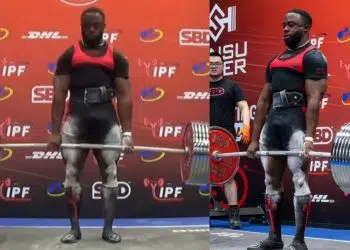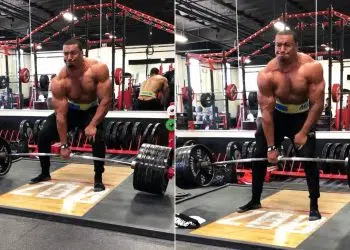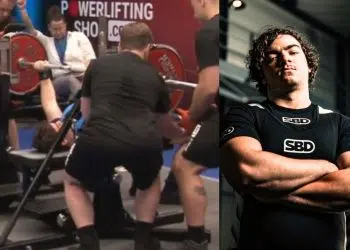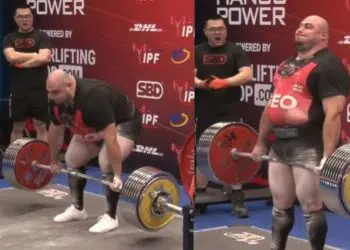Strength has been celebrated for thousands of years. For as long as humans have lived on planet Earth, they’ve tested their physical prowess by lifting rocks, logs, and any other heavy objects they could lay their hands on.
From the days of ancient Greece to modern times, strength competitions have drawn huge crowds who have marveled at the incredible feats performed by their favorite athletes.
Currently, there are two main strength sports – powerlifting and Olympic weightlifting. Both involve lifting heavy barbells, and the winner is the competitor with the biggest total.
However, while the uninitiated may view powerlifting and weightlifting as the same thing, they’re actually very different.
In this article, we reveal the differences between powerlifting and weightlifting.
Powerlifting vs. Weightlifting
Is there a difference between powerlifting and Olympic weightlifting? In short, powerlifting revolves around squats, bench presses, and deadlifts, while Olympic weightlifting revolves around snatchs and cleans and jerks. Both types of lifting require a great deal of strength.
Level Up Your Fitness: Join our 💪 strong community in Fitness Volt Newsletter. Get daily inspiration, expert-backed workouts, nutrition tips, the latest in strength sports, and the support you need to reach your goals. Subscribe for free!
History
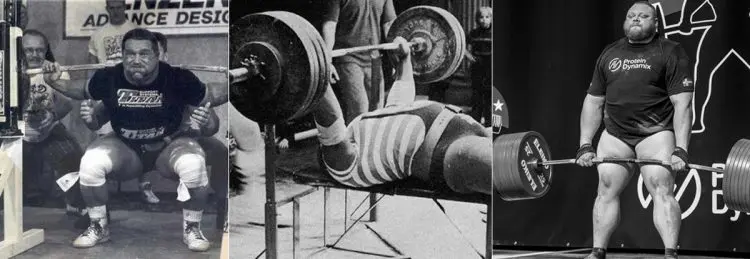
Olympic weightlifting is an old barbell sport dating back to the early 1890s. It was part of the 1896 Olympic games and has featured in almost every Olympics since then. Over the years, the official Olympic lifts have evolved, and some disciplines have been dropped from competition, but modern Olympic lifting has remained relatively unchanged since 1972.
In contrast, powerlifting has only been a recognized sport since the late 1950s. It started off as a sport of over 40 different lifts, incorporating anything that WASN’T one of the Olympic lifts. Contested powerlifts, also called odd lifts, included such exercises as the single-hand deadlift, floor press, bent press, hack squat, back lift, and other weird and wonderful tests of strength.
However, in the early 1960s, powerlifting became the sport of three lifts that are still contested today.
Related: Powerlifting Strength Training Programs and Olympic Weightlifting Guide Program
Contested Lifts
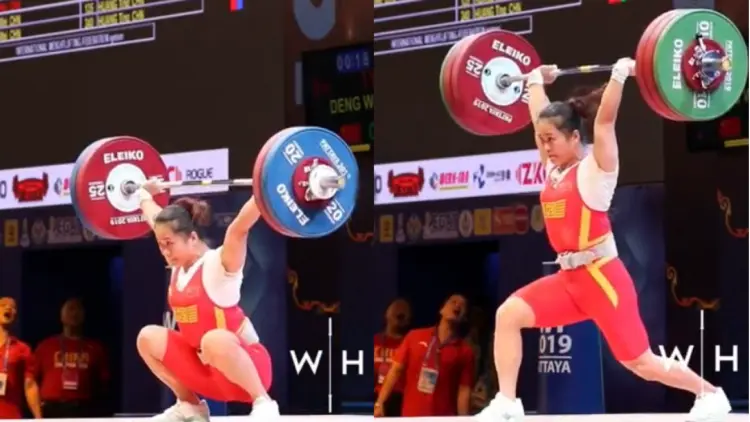
The most obvious difference between the sports of powerlifting and Olympic weightlifting is the contested lifts.
Powerlifting competitions involve three barbell lifts: the squat, bench press, and deadlift. Powerlifters can choose between doing conventional or sumo deadlifts as both are competition legal.
Some powerlifting events also include the strict curl. However, this is usually a separate event from the “big three” and doesn’t affect the outcome of the main competition.
Olympic lifting involves two barbell lifts: the snatch, and the clean and jerk. Until 1974, there was a third Olympic lift – the clean and press – but this was dropped from competition because of judging and safety concerns.
The clean and jerk involves two distinct movements. The clean is where the bar is lifted from the floor to the shoulders, while the jerk is where the bar is pressed from the shoulders to overhead.
In contrast, the snatch involves lifting the bar from the floor to overhead without stopping at the shoulders.
Competition Format
In both powerlifting and Olympic weightlifting, every athlete gets three attempts at each lift. The best attempts are added together to give a total, and the lifter with the biggest total wins.
Lifts are performed in a set order. For powerlifting, that’s:
- Squat
- Bench press
- Deadlift
In Olympic weightlifting, the order of lifts is as follows:
- Snatch
- Clean and jerk
Powerlifting competitions use a ‘lifter order’ approach. This means that all competitors attempt lifts in a set order. The weight on the bar is adjusted to match the lifting order.
In contrast, Olympic weightlifting competitions use a ‘rising weight approach. This means the bar continues to get heavier throughout the competition, and athletes are called to lift when their chosen weight is loaded.
However, all attempts must be approved by judges to count. If an athlete has three failed attempts for the same lift, they are disqualified from the competition.
In both sports, athletes are typically grouped by weight category and gender and, in some cases, by age, e.g., juniors or masters.
Clothing and Personal Equipment
While there are some similarities, clothing and personal equipment differ between powerlifting and Olympic weightlifting.
Clothing for Powerlifting
In competition, powerlifters must wear a snug-fitting, one-piece garment called a singlet. For squats and bench presses, lifters must wear a T-shirt under their singlet, but this can be dispensed with for deadlifts.
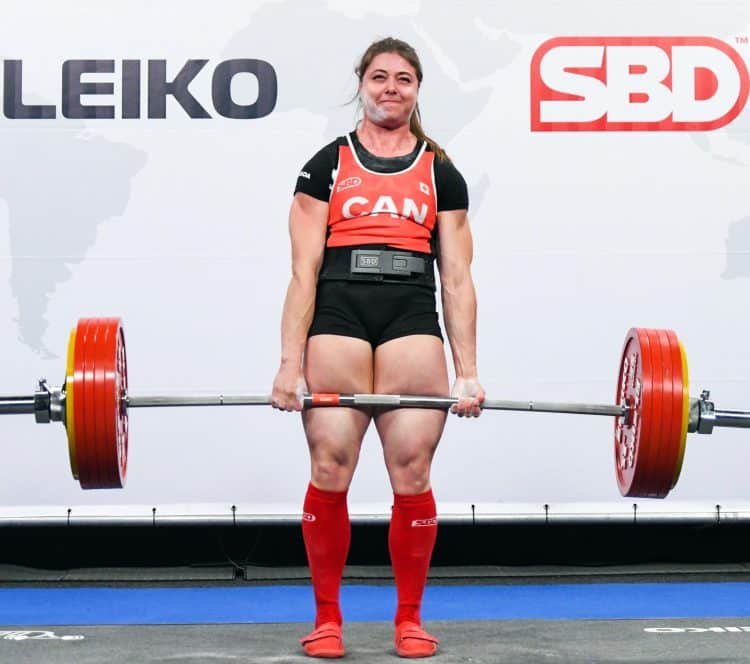
For squats, a lot of powerlifters wear weightlifting shoes, especially if they favor a narrow stance. However, some lifters wear minimalist shoes like Chuck Taylors. Depending on the rules of their federation, lifters may also wear knee wraps or sleeves, a weightlifting belt, or a supportive garment called a squat suit. Squat suits are only allowed in so-called equipped lifting competitions as they increase the weight that can be lifted.
In the bench press, lifters can wear whatever footwear they prefer. They can use a lifting belt if they wish, and a tight-fitting garment called a bench press shirt is allowed in equipped competitions. Some lifters also like to wear wrist wraps for added support and safety.
For the deadlift, most competitors wear thin, flat shoes or something called deadlift slippers. Lifting barefoot is not permissible. Lifters must also wear knee-length socks to prevent abrasions from the bar rubbing against their shins. Lifting belts are usually allowed, and lifters competing in equipped categories can wear supportive deadlift suits.
Check your federation’s rulebook to see what clothing and equipment is and isn’t permitted. For example, some “raw” powerlifting organizations allow knee wraps and sleeves, while others do not. There are also variances in the rules governing the use of squat suits, deadlift suits, and bench press shirts in equipped powerlifting competitions.
Related: Powerlifting Rules: The Basics
Clothing for Weightlifting
Like powerlifters, Olympic weightlifters compete in singlets, with or without a T-shirt. They also wear weightlifting shoes with raised heels. Knee sleeves and lifting belts are permitted, but additional supportive clothing or equipment is not allowed.
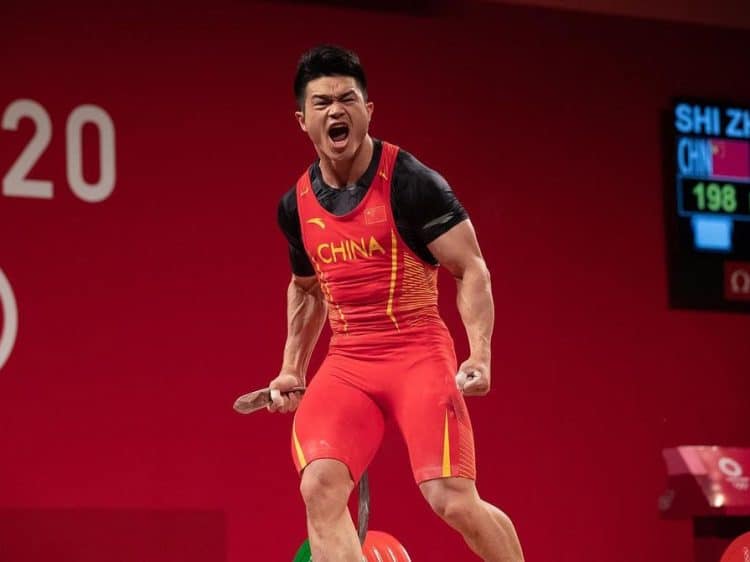
Equipment
Of the two sports, powerlifting is the most equipment-dependent.
Powerlifting Equipment
Squats are performed on a designated lifting platform using a squat or power rack. Some federations use a self-releasing device called a monolift, which saves athletes from having to walk back to get into the starting position for squats.
The bench press is done on a heavy-duty bench press station with adjustable J-hooks so the lifter can choose the height from which they unrack the bar. Many powerlifting bench press stations also have adjustable spotting arms. These prevent the lifter from being crushed under a heavy weight if they cannot complete a rep.
Of the three powerlifting events, the deadlift is the least equipment-dependent. Competitors perform their attempts on a designated lifting platform, which is usually the same area used for squats, but with the rack moved out of the way.
Powerlifting competitions usually use different barbells for each event. Squat bars and deadlift bars are different and designed to maximize the amount of weight that can be lifted. However, some smaller (and less well-funded) federations use the same bar for all three lifts.
Weightlifting Equipment
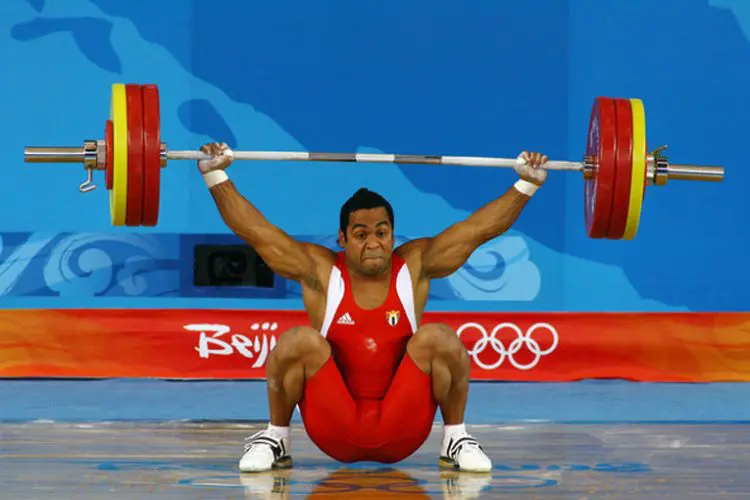
Olympic weightlifting involves much less equipment than powerlifting. Competitors perform each lift on a specially designed platform without the benefit of racks or stands. However, Olympic lifters DO use squat stands during training.
Level Up Your Fitness: Join our 💪 strong community in Fitness Volt Newsletter. Get daily inspiration, expert-backed workouts, nutrition tips, the latest in strength sports, and the support you need to reach your goals. Subscribe for free!
In competition, the snatch and clean and jerk start and finish with the barbell resting on the floor. Weightlifting platforms are made from shock-absorbing materials to protect the barbell and weights when they’re dropped at the end of a lift.
Competitors do not have to lower the weights to the floor after a lift, as this would be a waste of valuable energy. However, a dropped deadlift would result in a no-lift in powerlifting.
Olympic barbells and weight plates are also made to be dropped.
Technical Difficulty
While both barbell sports involve specialist techniques and skills, it’s fair to say Olympic lifting is the more difficult of the two. Most gym goers are familiar with the squat, bench press, and deadlift, even if they can’t do these exercises perfectly.
Because of this, many powerlifters are self-coached and can train in conventional gyms. A few modifications in technique (and plenty of heavy training) are all that’s needed to turn a recreational lifter into a novice powerlifter ready for their first competition.
In contrast, Olympic lifting is highly technical. The snatch and clean and jerk are not common gym exercises, and even experienced strength trainers may not be familiar with them. The best way to learn these lifts is under the guidance of a qualified coach, and that means joining a weightlifting club or gym.
Not only are the Olympic lifts harder to perform, but they also require a higher degree of mobility, flexibility, coordination, and balance than the big three powerlifts.
So, of the two sports, powerlifting is probably the easiest one to get into.
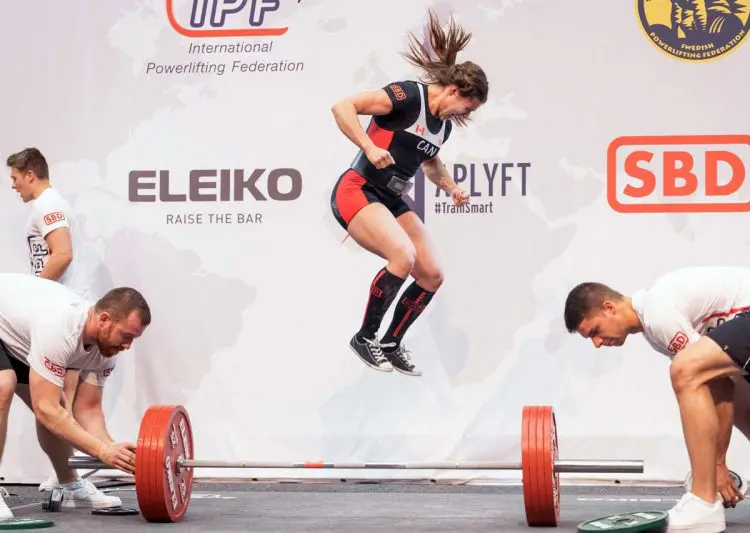
Governing Bodies
Like all sports, weightlifting, and powerlifting are controlled by governing bodies. These organizations determine the rules of the sports, set the competitive calendar, and otherwise run competitive events.
Olympic weightlifting is governed by the International Weightlifting Federation (IWF), which sets the rules for competition worldwide. There are also affiliated national bodies, including the British Amateur Weightlifting Association (BAWLA) in Great Britain and USA Weightlifting in America.
In contrast, powerlifting has multiple individual governing bodies, many of which have different rules and regulations. The biggest powerlifting body is the International Powerlifting Federation (IPF). Because of the various powerlifting federations, like boxing, there are several world champions within the same weight categories.
For any record to stand, it must be sanctioned by the relevant governing body.
Learn more about Powerlifting Weight Classes.
Strength vs. Power
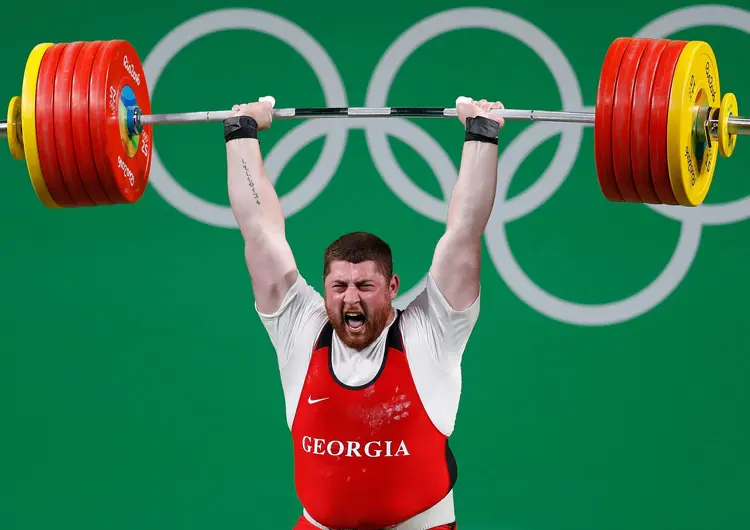
Strength and power are closely related but are also different. Strength is the ability of a muscle or muscle group to generate maximal force. This force is independent of speed. For example, a heavy squat is a test of strength.
In contrast, power is a force generated quickly, which means it combines strength and speed. A squat jump is an example of an activity requiring lots of power.
Because of the loads involved, powerlifters tend to perform the squat, bench press and deadlift relatively slowly. As such, and contrary to its name, powerlifting is a test of strength.
In contrast, the Olympic lifts are performed very quickly, so they are more of a test of power.
So, powerlifters are generally stronger than weightlifters, but weightlifters are more powerful than powerlifters. Maybe these sports should consider switching names!
Physique
Unlike bodybuilding, where muscle size, definition, and symmetry matter most, powerlifters and Olympic weightlifters have no real interest in how they look. As such, powerlifters and weightlifters don’t tend to be as ripped or as well-muscled bodybuilders. Some lifters for both sports even look quite unathletic despite their physical prowess.
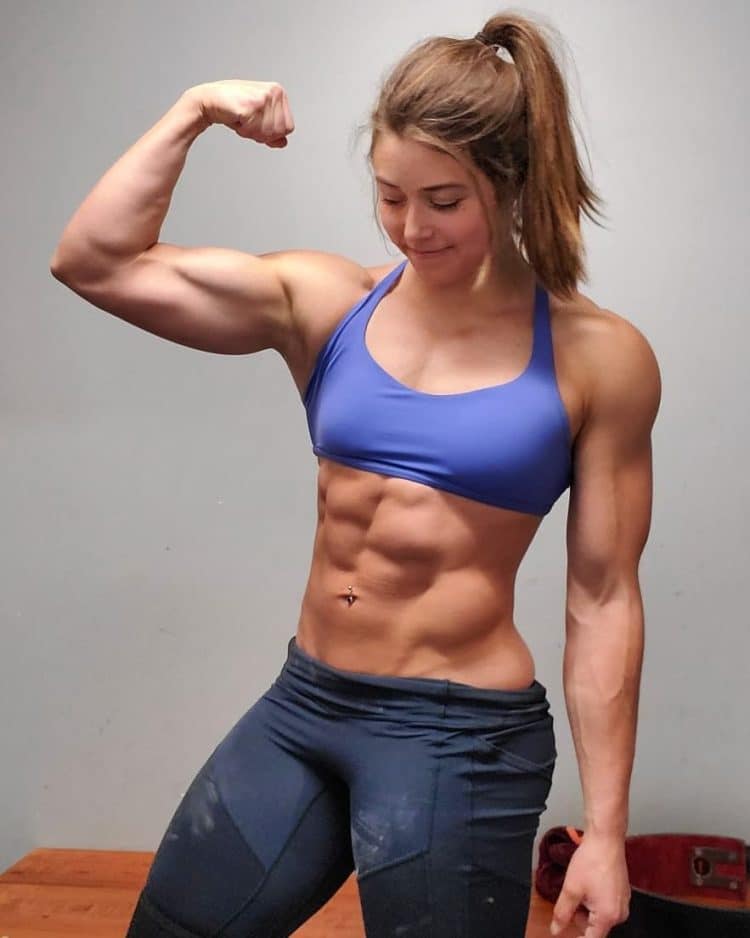
That’s not to say that powerlifters and weightlifters aren’t muscular – they usually carry far more muscle mass than the average person. However, that mass is purely functional and may not be especially aesthetically pleasing.
As both sports have weight categories, athletes in the lighter groups tend to be relatively lean, so they can be as heavy as possible without straying into the next weight classification. However, heavyweights have no such concerns, so they may carry a lot of body fat.
Because powerlifters squat, bench press, and deadlift, they usually have very well-developed quadriceps, hamstrings, glutes, lats, and pecs. In contrast, Olympic lifters tend to have very muscular quadriceps, deltoids, and traps.
While there are exceptions, most successful barbell sports competitors are mesomorphs, who are naturally muscular and strong.
Injury risk
Like most competitive sports, there is a risk of injury during powerlifting and Olympic lifting, both in training and competition. Most athletes will experience a few injuries during their careers.
Powerlifters tend to suffer knee, lower back, and shoulder injuries, while elbow injuries are relatively rare. Muscle strains are also a common problem, with pec tears being especially prevalent during the bench press.
Olympic lifters tend to experience similar knee, back, and shoulder issues but are also more prone to elbow problems.
Because of the velocity of movement and technical difficulty of the lifts, the injury risk is slightly higher for Olympic lifting than for powerlifting. Also, Olympic lifters tend not to use spotters, so failed attempts are more likely to result in injury.
However, despite these risks, powerlifting and weightlifting are still relatively safe sports, with an average of 2.6 injuries per 1000 hours of activity (1).
Closing Thoughts
So, while powerlifting and weightlifting are both barbell sports, they’re actually pretty different. Each involves different competitive lifts and equipment and is governed by different federations.
So, is one better than the other? Of course not!
While powerlifting is a sport of immense weights and less technical lifts, Olympic lifting is more technical and explosive. Powerlifting is more equipment-dependent and easier to learn. At the same time, Olympic lifting is much less equipment-dependent, but the lifts are harder to master.
Which one is right for you? Only you know the answer to that question.
Powerlifting is probably the way to go if you want to lift the heaviest possible weights. But, if you enjoy the challenge of technically-demanding exercises, you’ll probably prefer Olympic lifting.
Still on the fence? Then why not try them both!
They may be different, but powerlifting and Olympic lifting are also quite compatible. Doing both means you can enjoy all the benefits these sports offer.
And then there’s competitive strongman, which involves elements of powerlifting and weightlifting, and is another popular strength sport.
References:
- Raske A, Norlin R. Injury incidence and prevalence among elite weight and power lifters. Am J Sports Med. 2002 Mar-Apr;30(2):248-56. doi: 10.1177/03635465020300021701. PMID: 11912096. https://pubmed.ncbi.nlm.nih.gov/11912096/


